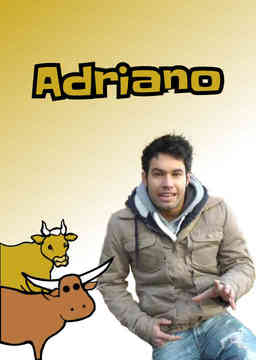









Difficulty:
 Intermediate
Intermediate
Italy
The Etruscans were influenced by other ethnic groups, particularly the Greeks. On display in the National Etruscan Museum of Villa Giulia, we find evidence of this in the terracotta objects and fine gold jewelry and precious objects dating from the period.
Difficulty:
 Intermediate
Intermediate
Italy
Eleonora introduces us to her two horses. She tells the story of how they came to be part of her life.
Difficulty:
 Adv-Intermediate
Adv-Intermediate
Italy
Actor Giulio Brogi talks about how his role in The Subversives mirrored his character at the time. The Taviani brothers describe how they found another actor in that film, young Lucio Dalla, the famous (and now deceased) singer-songwriter.
Difficulty:
 Intermediate
Intermediate
Italy
We get a look at the tomb, in terracotta, of a noblewoman. The clay allows for detail, where tombs in Macco do not. We then go to Rome, to the most important Etruscan museum, where we see once again, what an important role the afterlife played in the lives (and deaths) of the Etruscans.
Difficulty:
 Intermediate
Intermediate
Italy
Eleonora tells us about how she combines her love for animals, especially horses, with a path to a career.
Difficulty:
 Adv-Intermediate
Adv-Intermediate
Italy
San Miniato is where the Taviani brothers were born, but it was also the birthplace of their careers in filmmaking. Their first was a documentary and right away they had some problems with censorship.
Difficulty:
 Intermediate
Intermediate
Italy
We're still in Tarquinia and we visit the tomb of Aninas. We gain some insight into the alphabet the Etruscans used, allowing us to recognize some names, but unfortunately, they didn't leave much in the way of writings to allow us to know much more.
Difficulty:
 Adv-Intermediate
Adv-Intermediate
Italy
The Taviani brothers talk about how, as young movie lovers, they would grab their bikes and go to whatever movie theater in the area was showing their favorite films. Then they had to go to the big city, Rome, to pitch their first documentary. They learned a valuable lesson.
Difficulty:
 Intermediate
Intermediate
Italy
This magnificent, colorful tomb, dating to twenty-five hundred years ago, depicts a banquet in honor of the deceased, who is clearly a young man. It's a virtual time capsule.
Difficulty:
 Adv-Intermediate
Adv-Intermediate
Italy
The Taviani brothers lived through the war, so they had a good feel for the terror people felt. But as kids they were also very much affected by the movies offered at the time.
Difficulty:
 Intermediate
Intermediate
Italy
The Matuna family tomb contains many plaster reproductions of everyday objects, adding to the story of how the Etruscans lived. We move on to Tarquinia, where the tombs were carved out of a sedimentary limestone called Macco, allowing the colorful wall paintings to be preserved.
Difficulty:
 Adv-Intermediate
Adv-Intermediate
Italy
This documentary is about 2 brothers — the Taviani brothers — who are famous for having made many award-winning Italian movies. The short clips from their films will surely entice us to see the complete movies in the original Italian. Perhaps the most famous one is La Notte di San Lorenzo from 1982, whose English language release had the title: The Night of the Shooting Stars.
Difficulty:
 Intermediate
Intermediate
Italy
One of the most famous tombs is that of the Matuna family. The reproductions and depictions of objects found there, ranging from everyday tools to ceremonial and funereal ones, allows us a glimpse of what life would have been like in this ancient civilization.
Difficulty:
 Intermediate
Intermediate
Italy
There were different kinds of tombs built by the Etruscans. Alberto Angela explains how and why they were made the way they were. He also takes us into one of the most famous and beautiful Etruscan tombs.
Difficulty:
 Intermediate
Intermediate
Italy
The Etruscans were an important part of Italy's ancient history, and its lands extended for a large expanse of the peninsula. We visit Banditaccia a Cerveteri, a necropolis north of Rome.
Are you sure you want to delete this comment? You will not be able to recover it.